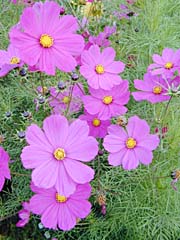|
Aug. 25, 2005
Summer's not over yet!by AMY STEWART IF YOU LIVE NEAR THE COAST LIKE
I DO, you're probably wondering what happened to summer. It's
as if the season showed up for a couple of days, looked around
and said, "Well, never mind." Like a houseguest who
is not nearly as excited about visiting you as you hoped they
would be, summer showed up with full suitcases and a tote bag
packed with reading material, looking as if it might stay a few
months, then nonchalantly announced that it was really only passing
through on its way to Portland, but thanks for fixing up the
guest room all the same. But don't give up hope. September and October can be surprisingly warm and sunny, so there are still plenty of possibilities for the garden. The trick is to treat the fall like a full gardening season all its own, not just a graceful decline into winter. Think of Labor Day as a beginning, not an end. Here's what I'll be up to this weekend: WATER. The most important thing you can do for your garden right now is to give it a good, deep soaking once or twice a week. Even when it's cloudy all day, even when the sidewalks are damp with dew in the morning, the ground does dry out. Plants that don't have enough water stop growing and blooming, and they're less able to take up the nutrients that are in the soil. Avoid overhead watering, which can bring on disease, by using drip irrigation or just letting the hose trickle under shrubs and trees. FEED. Seriously, there's a long blooming season still ahead. Really. I mean it. Scratch a dry, organic "Fruit and Flower" formula in the soil around roses and other shrubs. Use a liquid fertilizer that contains fish emulsion, kelp meal and worm castings and spray it directly onto leaves as a foliar fertilizer. Or brew your own compost tea by mixing aged compost and worm castings with water and pouring around plants that need a lift. (The best compost tea is brewed for 24 hours first, but to do that you need an aquarium bubbler or something that will keep the water oxygenated to help feed the beneficial aerobic bacteria. If you don't have the gear for that, just stir and pour.) DEADHEAD. Shear back flowering perennials to get rid of dead flowers and seed heads. Low-growing, spreading groundcovers like geranium, catmint and yarrow will burst right back into bloom if they're cut back this time of year. Even lavender will produce some more flowers if you just keep cutting, but be sure to leave at least a third of the greenery on the plant -- lavender won't re-bloom on old, bare wood. MULCH. I know, again with the mulching. But really, there's nothing better than a pile of rotting grass clippings, leaves, maybe a little manure from the chicken coop and some old kitchen scraps to reinvigorate the garden and keep the soil moist. If you're not making it yourself, buy a couple bags. Spread it over bare spots in the soil and around the plants that need to perk up. PLANT. You heard me, plant. There's plenty of time. You can get some herbs in the ground -- in fact, the (slightly) warm fall months are sometimes the only time I can get basil and cilantro to grow -- and there's plenty of time for a few crops of lettuce before winter. In fact, if you start out with regular mesclun mixes and gradually start sowing cold-tolerant arugula, spinach and mache, you'll have salad greens at Christmas. It's also a good time to plant beets, broccoli and Brussels sprouts so that you can show off at Thanksgiving by bringing vegetables from the garden. There's still time for flowers, too. In my neighborhood, gardeners are just getting started on sunflowers. Icelandic poppies and bachelor button will bloom through fall. Rudbeckia (Black-eyed Susan) still has time to get going, and this year I'm even experimenting with planting cosmos in August. They are surprisingly intolerant of cool weather, but I'm hoping for just enough warmth this fall for a quick crop. Finally, remember that fall is the best time to plant perennials. If you want to make any big changes in the gardenadd a tree or shrub, put in a new flower bed -- now's the time to get it figured out. When it comes to perennials, don't look for glamorous, blooming plants in the nursery. Find something with a sturdy root system and healthy green growth, and plant when the fall rains start. They'll have all winter to put down roots and get ready to bloom in spring. garden-related announcements and news to Amy Stewart. COVER
STORY | IN THE NEWS | THE HUM | © Copyright 2005, North Coast Journal, Inc. |


